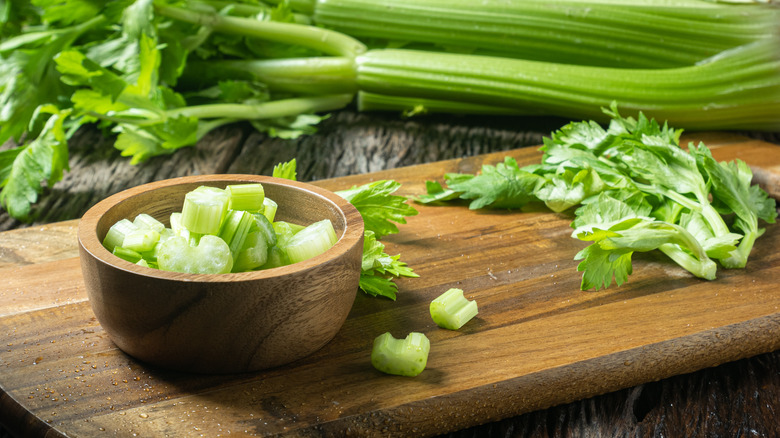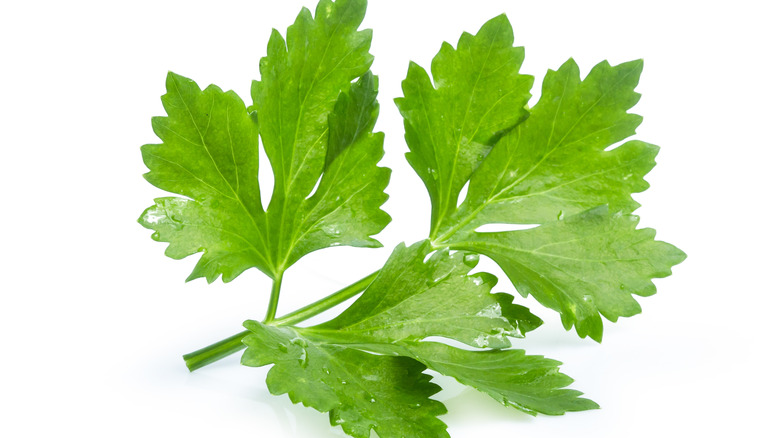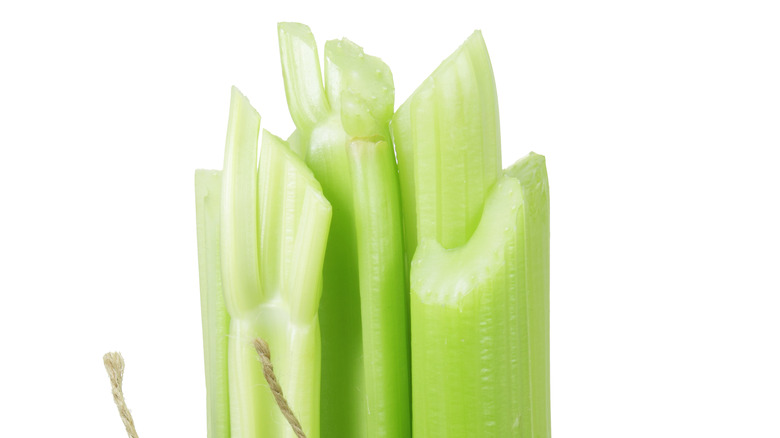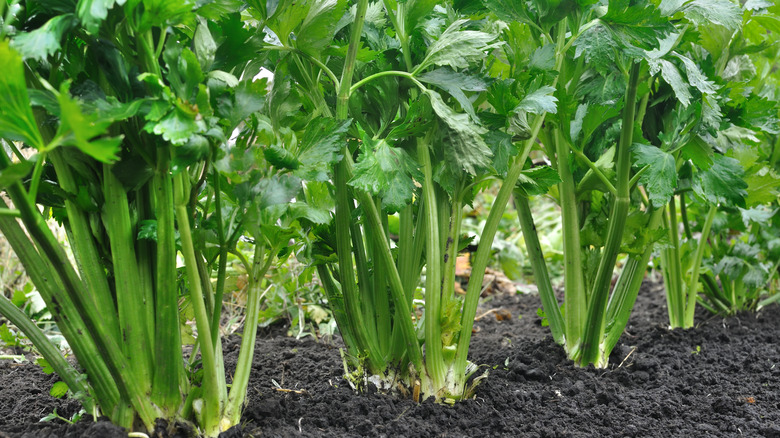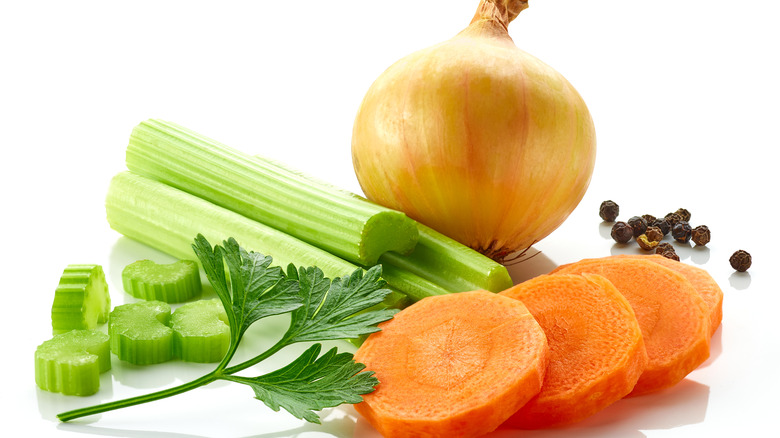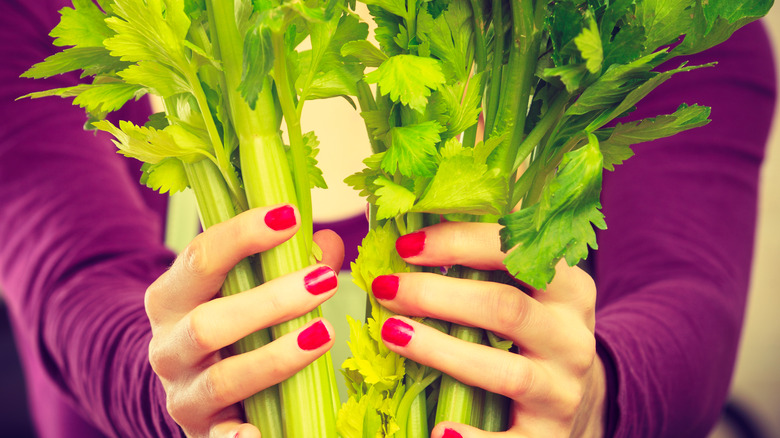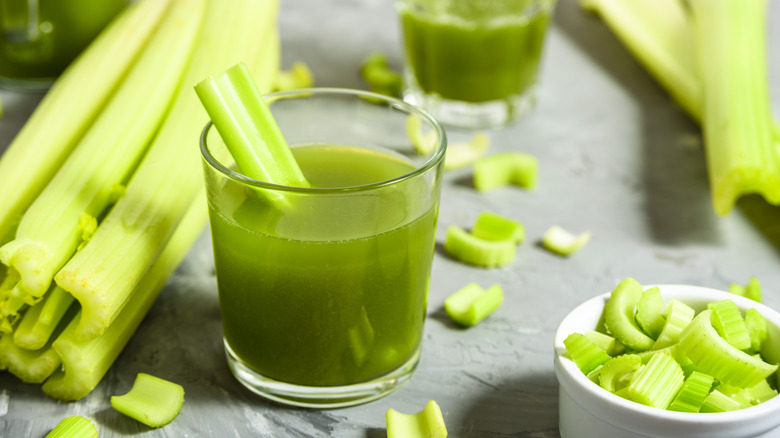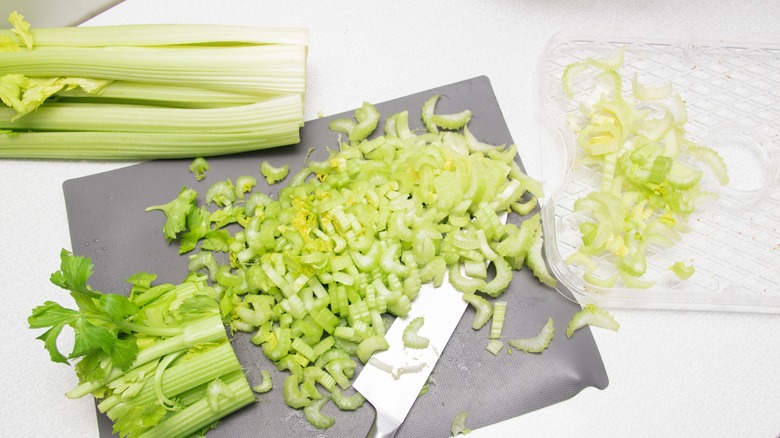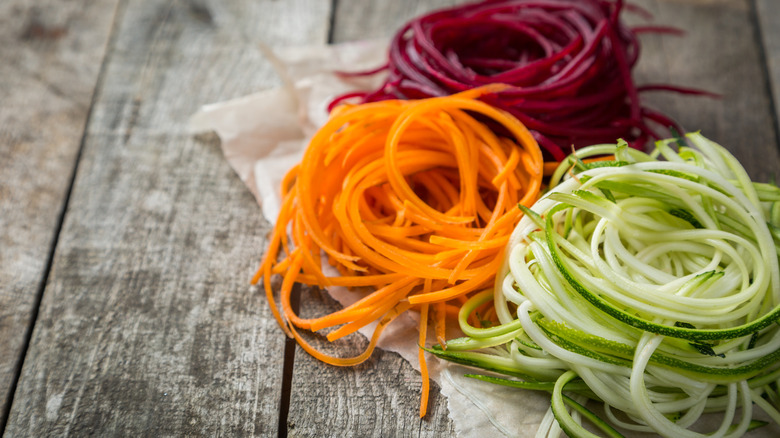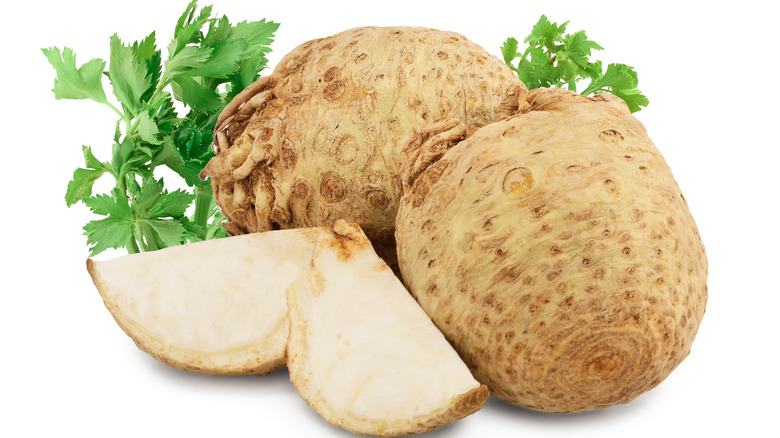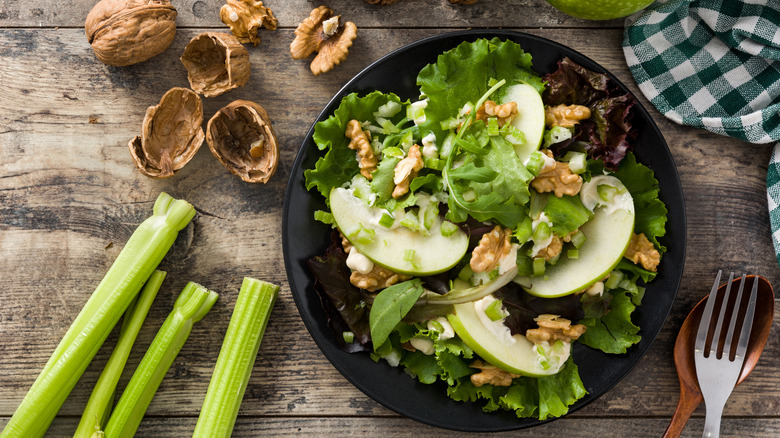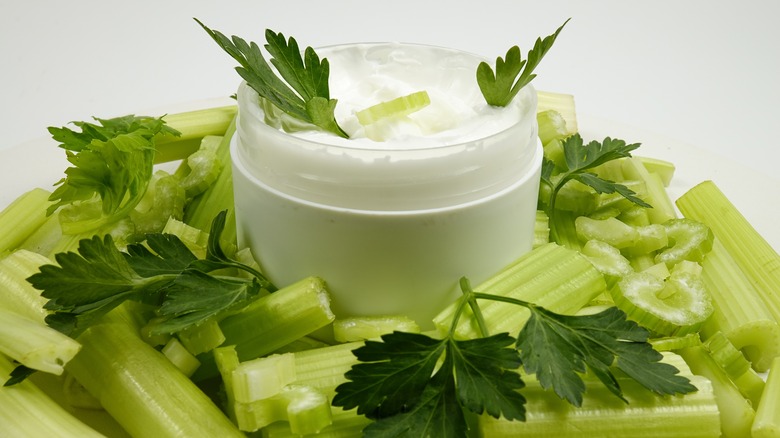15 Tips You Need When Cooking With Celery
With its mild taste, hard-to-pinpoint flavor, and crunchy texture, celery is an interesting vegetable with fans and detractors. For some people, it's a crunchy and tasty vegetable that improves many foods, while for others, it has a bland taste and an obnoxious texture because of its strings. No matter what you think of celery, it clearly can polarize opinions.
Celery is a very nutritious vegetable, according to Healthline. It's loaded with antioxidants, can reduce inflammation, is full of fiber and supports digestion, has a low glycemic index, and has an alkalizing effect. It started not as a vegetable used for cooking but as a medical plant (via NPR). Celery was used in cooking in the 1600s in Europe to make feeding larger families easier, as it is a vegetable that works great with meat. Over time, people started consuming all parts of celery and developed different varieties that emphasized the growth of the stem, the root, or the leaves of the plant. As such, there are many ways to consume celery. Here are some tips to help you when cooking with celery.
Keep celery fresh for longer
When choosing celery stalks, there are a few things to consider. According to Texas Real Food, the most important thing is to look for firm stalks with medium-thick ribs. These should be crisp and break easily when bent. Also, check the leaves; they should have a vibrant green color with no brown spots or discoloring. Avoid buying celery with wilted leaves or yellowing spots, as this indicates that it is not fresh. Finally, make sure that the stalks are not too thick, as this can make them difficult to cook.
After buying fresh celery, make sure you use the best storage methods to keep it fresh for a long time. For starters, remove the celery head from any plastic bag it may come in and remove the leaves. These are usually the first to spoil, so without them, the shelf life of your veggie will increase. Then, wrap a paper towel around the celery head and add an aluminum layer. If you have celery sticks, you can store them in the original plastic package. Or you can place them in an airtight container with some water. Finally, you can also freeze chopped celery. For maximum efficiency, try flash-freezing the celery pieces so they don't stick together.
Be careful about allergic reactions to celery
Although there is little research on the subject, celery can cause allergic reactions in some people. According to Allergy UK, the allergic reactions caused by celery are related to pollen food allergies. Allergic reactions to celery range from mild to severe and, in some cases, can be life-threatening, requiring adrenaline injections. In addition, people allergic to celery may experience itching, swelling, hives, and difficulty breathing. Milder reactions may also include nausea, vomiting, and diarrhea.
It has been observed that most celery allergy cases occur in countries where celery is often consumed raw, such as Germany, Switzerland, and France (via The University of Nebraska-Lincoln). Therefore, people with a celery allergy should avoid eating it altogether, as even trace amounts of celery can trigger an allergic reaction in some individuals. Today, it is mandatory to list celery as an allergen on food labels precisely because of the occurrence of allergic reactions. Often, people are unaware that parts of the plant are used to flavor certain foods, such as stock cubes, gravy granules, soups and broths, dressings, sauces, spice mixes, or tomato juice. Therefore, if you know that you can develop an allergic response to celery, it's best to check the label on any such product.
Save celery leaves and use them in cooking
If you're removing celery leaves to keep them fresh for longer, don't be too fast to throw them away. Although they are often overlooked, celery leaves are an incredibly nutritious and flavorful addition to many dishes. Not only do they add a unique, robust, and earthy flavor to food, but they also provide a great source of vitamins and minerals. Celery leaves can be used in various ways, from adding them to smoothies or juices to using them as a cooking base for soups and stews alongside carrots and onions. They can also be added to salads for extra nutrition and flavor.
Saving celery leaves is a good idea as they are fantastic for use as a flavorful vegetable base for soups and stews. They are outstanding in recipes that require celery stalks, as they will enhance the aroma. Ideally, the leaves will be removed from the dish after cooking because their texture is not always compatible with soups or stews. However, you can add celery leaves to recipes that call for celery stalks or substitute them entirely. Make sure you use them in moderation, as the aroma can be overpowering. Additionally, raw celery leaves can be added or cooked into salads for extra crunch and flavor.
Destring celery to get rid of the unappealing texture
The most common complaint concerning celery is the stringy texture, which can be more evident in the outer stalks of the plant. If you have ever had to deal with celery strings, you know how frustrating they can be. The good news is that there are ways to change the way you cut celery so you can enjoy its flavor without the texture!
One way to destring celery is by using a vegetable peeler or kitchen knife. Start by peeling away any tough outer layers of the celery stalks and then peel off any strings left behind. You can also snap the base and pull the thick threads. If you opt for the inner stalks in a celery head and avoid the outer ones (they are usually larger, stringier, and more bitter), you will get a smoother texture and a better taste. These methods are helpful when consuming raw celery. In addition, if you cook it, the strings will become soft and unnoticeable so that they don't bother you anymore.
Avoid eating too much celery
While celery may be a popular food to include in diets, it is essential to remember it should be eaten in moderation. Celery became a popular vegetable because it was linked to weight loss. As a result, countless diets were based on celery or celery juice, but they posed real health risks. When you eat too much celery, it can lead to acute health issues as the vegetable is low in calories, vitamins, and minerals. It also contains a lot of dietary fiber, which can cause digestive problems and gallstones if consumed excessively.
Although celery has some vitamins and can contribute to weight loss because of its high fiber content, celery does not provide the body with enough nutrition to function correctly. It is important to eat a variety of foods to get all the nutrients that your body needs. A diet consisting primarily of celery can cause nutrient deficiencies and energy loss and affect the brain's functions, as celery is low in protein, iron, and calcium.
Use celery as a building block in cooking
While some may consider celery to have a bland, uninteresting flavor, this vegetable is much more than it seems. Its taste varies from a somewhat bitter aroma when raw to almost sweet when cooked, and the texture can be both crunchy and soft, depending on how you use it. Celery is part of the French mirepoix; being a part of this renowned vegetable base proves that its flavor is intense and interesting enough to start giving celery the respect it deserves.
The earthy, sweet aroma of cooked celery is incredibly delicious in recipes such as stock, stew, stuffing, or casserole. It can even be part of a flavor-filled Bolognese ragù. On the other hand, the crunchy texture is ideal in salads and brings a burst of juice. And, if you need final proof that celery is a great building block in cooking, look at the various ways you can use the various parts of the plant: From the pureed or roasted root (think of a veggie celery root steak) to the juicy stalks and the flavorful leaves, celery can be used top to bottom.
Steam celery to preserve its nutrients while cooking
Preserving nutrients and vitamins in veggies while cooking is a long-debated subject, and certain opinions state that most cooking methods will cause vegetables to lose most of their nutrients. However, according to a study in Food Science and Technology, celery preserves most of its nutrients when steamed and a significant amount when boiled or blanched.
To steam celery, start filling a pot with enough water to cover the bottom. Place the celery into the pot and bring it to a boil over medium-high heat. Once boiling, reduce heat to low and cover with a lid. Allow celery to steam for 4 to 5 minutes until tender but still crisp. Remove from heat and drain off any excess water before serving or adding to other dishes.
Alternatively, you can also blanch or boil your celery if you prefer it softer or are looking for an even quicker cooking time than steaming offers. To blanch, add celery pieces into boiling water for 2 to 3 minutes before draining any excess liquid.
Do your research about celery juice
Celery juice quickly rose to fame based on a book that claimed it was a miracle drink. The book was written by Anthony William, a self-proclaimed "Medical Medium." He affirmed that celery juice was high in antioxidants and had anti-inflammatory properties, which could help reduce joint pain and swelling. However, according to New York Times, these claims were never backed by scientific evidence and research, so calling celery juice a miracle is an overstatement.
That doesn't mean the juice lacks nutrition, just that it's not a magical cure. According to nutritionists, drinking celery juice represents a good habit if you don't eat a lot of vegetables because it provides certain vitamins and nutrients. But if you're looking for something that will improve your eating habits, you must look beyond a single vegetable and add variety to your eating. And, as far as antioxidants are concerned, you're better off with scientifically proven sources, such as tea.
Learn about celery substitutes
Craving celery's crunchy texture or warm flavor, but you forgot to buy some? Or did the ingredient pop up in a recipe where you thought it was improbable? Don't worry; there are many options to substitute celery.
Some of the most common celery substitutes include green onions, fennel, jicama, carrots, bok choy, water chestnuts, bell pepper, and celery seed. Green onions are a great substitution choice because of their crunchy texture. Fennel also has a similar taste and crunch to celery but has a slightly sweeter flavor. Jicama is another good swap for celery, as it has a mild flavor and crunchy texture. Carrots can also be used as an alternative to celery because they taste sweet and earthy. For something greener, bok choy is another alternative to celery due to its mild flavor and crisp texture. You can also use water chestnuts, bell pepper, and celery seed. Just make sure you adapt to the recipe you're cooking.
Avoid spiralizing celery
The popularity of zoodles (keto-friendly zucchini noodles) skyrocketed in the past few years. The spiralizer came to be used for almost any kind of vegetable. However, celery proves that even this popular kitchen staple has its limits. There are a few reasons why you'd want to avoid putting celery in your spiralizer.
Celery stalks are too narrow and soft to be effectively spiralized. The blades of most spiralizers just won't cut through them properly, so you risk hurting yourself because you can't grip them safely. For the spiralizer to work correctly, you need firmer vegetables that also come in a wider shape. Generally, root vegetables are suitable for the spiralizer. Try other vegetables, such as courgette, root vegetables, such as carrots and sweet potato, or fruit, such as apples. You might want to try spiralizing celery root, but ensure you cut it into easy-to-hold pieces. You can add the zoodles to salads or soups or serve them as a side dish. As far as celery is concerned, stick to other chopping techniques that won't result in cutting your fingers.
Get to know celery's relatives
Celery is a vegetable that allows for all parts to be used in cooking. Therefore, certain foods relate to it, and certain recipes require a specific part of the plant. If you're a fan of this vegetable, it would probably be helpful to learn more about it.
Celeriac is the name given to the root part of the plant. Some plants came to be cultivated for the stalks, while others are grown for the root part. Celeriac is usually large and has a round shape and a texture entirely different from celery. It resembles parsley, but the taste is closer to celery, without the freshness or the peppery flavor. Instead, the difference between celery and celeriac is that the latter is more earthy, with an intense aroma that becomes sweet when cooked.
On the other hand, celery salt is a seasoning made with celery seeds and salt. It is essential for some staple foods, such as Bloody Mary cocktails, KFC-style spices, or Chicago hot dogs. It is saltier and spicier than celery and has a more concentrated aroma. You can use it to substitute or complete any food that includes celery.
Add celery to salad for crunch
A good salad works both as an individual dish and a side dish. And what's better during a hot summer day than to indulge in a fresh, citrusy, peppery, and crunchy celery salad, in which the veggie's earthy flavor is completed by hazelnuts and olive oil and paired with grated bottarga and grapefruit juice?
This celery salad recipe, featuring grapefruit and bottarga, brings out what's best in each component. It's a flavor explosion meant to intrigue and delight even the pickiest eater because the flavor and texture combination is so unexpected and diverse. Also, the recipe is effortless, as only the hazelnuts are baked to enhance their aroma while the rest of the ingredients stay fresh. The main ingredient is crunchy celery stalks combined with chopped celery leaves. Sprinkled with tart grapefruit juice and olive oil and topped with hazelnuts and grated, saline bottarga, it's a well-rounded and refreshing plate.
Stuff celery for a flavor boost
Stuffed celery appetizers are delicious and incredibly versatile – you can switch out the ingredients depending on your preference or dietary restrictions. They are also kid-friendly and a great way of determining children to eat vegetables. Cream cheese works excellent for stuffing celery. For a finer and more complex taste, try adding shredded cheese to enhance the savory flavor or, better yet, make everything better with bacon and scallions.
This stuffed celery appetizer recipe pairs the crunchy celery with cheese cream, bacon, and scallions. The dish is the perfect way to start a meal or serve as an appetizer at your next gathering. The combination of soft cream cheese, salty bacon, and crunchy celery will please any crowd. Plus, it only takes minutes to whip up! First, try using a vegetable peeler to make a flat surface on the bottom of the celery sticks. After baking the bacon in the oven to make it crunchy, chop it into fine pieces. Next, make the cream, combining cream cheese, Dijon mustard, scallions, lemon zest, bacon, and bacon fat. To assemble, fill the celery logs with the cream cheese mixture, then garnish with celery leaves and some pepper.
Flavor sauce with celery and serve it with eggs
Eggs are among the best possible options for breakfast. No matter how you prefer them, they are nutritious, taste great, and are a filling dish that gives you energy for a long time. If you're looking for ways to diversify how you cook eggs, try pairing them with celery (the flavor combination works excellently) and baking them in celery cream.
This farm egg baked with celery cream recipe works great as a brunch dish. First, make the sauce, combining cream, chopped celery stalks, shallots, onions, peppercorns, a bay leaf, thyme, and salt, and simmer it for five minutes. Then, steep the cream for 15 minutes and strain it to withhold the larger ingredients. Bake some bread in the oven, then butter four ramekins, crack an egg into each baking dish, and top it with cream mixture, leaving the yolk exposed. Cook the eggs in the oven for approximately five minutes (until the egg whites start to set). Then, turn the oven's broiler until the eggs are slightly browned, and serve them with warm bread.
What shines about this dish is the nuanced flavor profile. The fullness of eggs mixes with the vegetal bite of celery for a complex layering that one doesn't always encounter in a standard meal.
Garnish a Bloody Mary cocktail
If you've never had a Bloody Mary cocktail and you see one with its classic garnish, a celery stick, you might find it odd, to say the least. What does a celery stick (let's be frank, many people consider it a very bland vegetable) have to do with the obvious tomato juice in the cocktail and the alcohol? It looks like someone is trying too hard to pair some things that don't work together.
They work together great. Bloody Mary is the cocktail for those who want to enjoy a brunch cocktail but are looking for something savory with a pinch of alcohol. And, beyond the brightly-colored ingredients that you can see, there is more. This classic Bloody Mary recipe shows you what. The cocktail mixes tomato juice with vodka, lemon juice, Worcestershire sauce, Tabasco sauce, pepper, and celery salt. The characteristic flavor comes from combining tomato juice, Worcestershire sauce, and celery salt. They work together like a charm. And if you add the spicy kick of Tabasco sauce and pepper, you have the savory competitor of mimosas.
